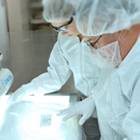BIOTIUM
Lieferant:
Biotium
Beschreibung:
Recognizes a protein of 40 kDa, identified as Thyroid transcription factor-1 (TTF-1). TTF-1 is a member of the NKx2 family of homeodomain transcription factors. It is expressed in epithelial cells of the thyroid gland and the lung. Nuclei from liver, stomach, pancreas, small intestine, colon, kidney, breast, skin, testes, pituitary, prostate, and adrenal glands are unreactive. Anti-TTF-1 is useful in differentiating primary adenocarcinoma of the lung from metastatic carcinomas originating in the breast, mediastinal germ cell tumors, and malignant mesothelioma. It can also be used to differentiate small cell lung carcinoma from lymphoid infiltrates.Loss of TTF-1 expression in non-small cell lung carcinoma has been associated with aggressive behavior of such neoplasms. TTF-1 reactivity is also seen in thyroid malignancies.
Lieferant:
Biotium
Beschreibung:
This MAb reacts with a reduction-resistant epitope present in both free and SIgA bound Secretory Component. It does not react with the cell lines lacking secretory component. The antibody is useful for studying the distribution and level of both free and bound secretory component. Secretory component is differentially expressed in epithelium, and the antibody is a popular marker for identifying subpopulations of epithelial cells and epithelial differentiation. The Secretory component antibody is a useful research tool for studying mucosal immunity, inflammation, remodeling, differentiation and tumorigenesis, all processes associated with differential secretory component expression.
Lieferant:
Biotium
Beschreibung:
This antibody recognizes a 56 kDa protein, which is identified as Early Mitotic Inhibitor-1 (EMI1). It regulates mitosis by inhibiting the anaphase promoting complex/cyclosome (APC). Emi1 is a conserved F box protein containing a zinc-binding region essential for APC inhibition. The Emi1 protein functions to promote cyclin A accumulation and S phase entry in somatic cells by inhibiting the APC complex. At the G1-S transition, Emi1 is transcriptionally induced by the E2F transcription factor. Emi1 overexpression accelerates S-phase entry and can override a G1 block caused by overexpression of Cdh1 or the E2F-inhibitor p105 retinoblastoma protein (pRb). Depleting cells of Emi1 through RNA interference prevents accumulation of cyclin A and inhibits S phase entry.
Lieferant:
Biotium
Beschreibung:
Anti-IgG Goat Polyclonal Antibody (CF™ 640R)
Lieferant:
Biotium
Beschreibung:
Recognizes a glycoprotein of ~200 kDa, identified as carbonic anhydrase IX (CAIX/gp200). Carbonic Anhydrases (CAs) are members of a large family of zinc metallo-enzymes that catalyze the reversible hydration of carbon dioxide. CAs are involved in a variety of biological processes, including respiration, calcification, acid-base balance, bone resorption and the formation of aqueous humor, cerebrospinal fluid, saliva and gastric juice. They show extensive diversity in distribution and in their subcellular localization. CA IX is specifically expressed in clear-cell renal carcinomas.
Lieferant:
Biotium
Beschreibung:
This antibody recognizes an oncofetal glycoprotein with a single chain of 70 kDa, which is identified as alpha fetoprotein (AFP) (ISOBM TD-2 workshop). This MAb is highly specific to AFP and shows no cross-reaction with other oncofetal antigens or serum albumin. AFP is normally synthesized in the liver, intestinal tract, and yolk sac of the fetus. Antibody to AFP has been shown to be useful in detecting hepatocellular carcinomas (HCC) and germ cell neoplasms, especially yolk sac tumors.
Lieferant:
Biotium
Beschreibung:
Goat anti-mouse IgG (H+L), F(ab')2 fragment secondary antibody labeled with our superior CF® dyes and other labels.
Artikel-Nr:
(BNUM1090-50)
Lieferant:
Biotium
Hersteller-Artikelnummer::
BNUM1090-50
Lokale Artikelnummer::
BTIUBNUM1090-50
Beschreibung:
MAb IPO-10 defines the antigen, which appears on B cell progenitors following HLA-DR and preceding CD10, CD19, CD22, CD37 and cym. It is expressed on resting B cells and than reappears and persists in cytoplasm and on cell surface until cytoplasmic Ig appears. It is a useful antibody for diagnostics of neoplasms of B cell origins. It reacts with human B cell lines Daudi, Raji, Namalva, EB-3, RPMI-8226 (50% of cells). The MAb does not label T cell lines, blood granulocytes, thymocytes or bone marrow stromal fibroblasts. No significant changes are detected after PHA or ConA stimulation while LPS and PWM stimulated cultures after 18-48h show decreased number of antigen-positive cells but in final terms of cultivation antigen is expressed again. This MAb labels B cell leukemias and some lymphomas. Hairy cell leukemia strongly reacts and 70% of B cell CLL and some B-NHL were also positive. IPO-10 reacts with AMML cells and in a majority of Hodgkin's disease cases a significant percentage of affected lymph node cells were detected.
VE:
1 * 50 µl
Lieferant:
Biotium
Beschreibung:
Recognizes a protein of 210-220 kDa, which is identified as the complement receptor 1 (CR1)/CD35. This MAb is specific for a site in CR1 that is distal from the C3b-binding site, so that it is unable to block CR1 activity. This MAb is highly specific to CR1 and shows no cross-reaction with CR2. The primary function of CR1 is to serve as the cellular receptor for C3b and C4b, the most important components of the complement system leading to clearance of foreign macromolecules. The Knops blood group system is a system of antigens located on this protein. Follicular dendritic cells (FDC) are restricted to the B-cell regions of secondary lymphoid follicles. They are CD21 /CD35 /CD1a-. This MAb labels follicular dendritic cells and follicular dendritic cell sarcoma.
Lieferant:
Biotium
Beschreibung:
CD8 is a cell surface receptor expressed either as a heterodimer with the CD8 β chain (CD8 α/β) or as a homodimer (CD8 α/α). A majority of thymocytes and a subpopulation of mature T cells and NK cells express CD8a. CD8 binds to MHC class 1 and through its association with protein tyrosine kinase p56lck plays a role in T cell development and activation of mature T cells. For mature T-cells, CD4 and CD8 are mutually exclusive, so anti-CD8, generally used in conjunction with anti-CD4. It is a useful marker for distinguishing helper/inducer T-lymphocytes, and most peripheral T-cell lymphomas are CD4 /CD8-. Anaplastic large cell lymphoma is usually CD4 and CD8-, and in T-lymphoblastic lymphoma/leukemia, CD4 and CD8 are often co-expressed. CD8 is also found in littoral cell angioma of the spleen.
Lieferant:
Biotium
Beschreibung:
This MAb recognizes a single chain, transmembrane, heavily glycosylated protein of 90-120 kDa, which is identified as CD34. Its expression is a hallmark for identifying pluripotent hematopoietic stem or progenitor cells. Its expression is gradually lost as lineage committed progenitors differentiate. CD34 is a marker of choice for staining blasts in acute myeloid leukemia. In addition, CD34 is expressed by soft tissue tumors, such as solitary fibrous tumor and gastrointestinal stromal tumor. Its expression is also found in vascular endothelium. Additionally, it appears that proliferating endothelial cells express this molecule more than the non-proliferating endothelial cells. Anti-CD34 labels > 85% of angiosarcoma and Kaposi's sarcoma, but with a lower specificity.
Lieferant:
Biotium
Beschreibung:
This antibody recognizes a ~90-95 kDa protein which is identified as cell surface transferrin receptor (CD71), a disulfide-bonded homodimeric glycoprotein of 180-190 kDa. This MAb is highly specific to CD71 and shows no cross-reaction with other related proteins. Its epitope is localized in the extracellular domain of CD71. Ligand for transferrin receptor is the serum iron transport protein, transferrin. This receptor is broadly distributed in carcinomas, sarcomas, leukemias, and lymphomas. CD71/Transferrin receptor has been reported to be associated with cell proliferation in both normal and neoplastic tissues and useful in predicting clinical behavior or response to therapy in a number of malignancies including breast cancer.
Lieferant:
Biotium
Beschreibung:
This MAb recognizes basic (Type II or HMW) cytokeratins, which include 67 kDa (CK1); 64 kDa (CK3); 59 kDa (CK4); 58 kDa (CK5); 56 kDa (CK6); 52 kDa (CK8). Twenty human keratins are resolved with two-dimensional gel electrophoresis into acidic (pI 6.0) subfamilies. The acidic keratins have molecular weights (MW) of 56.5, 55, 51, 50, 50 , 48, 46, 45, and 40 kDa. Many studies have shown the usefulness of keratins as markers in cancer research and tumor diagnosis.
Lieferant:
Biotium
Beschreibung:
This MAb is specific to lambda light chain of immunoglobulin and shows no cross-reaction with lambda light chain or any of the five heavy chains. In mammals, the two light chains in an antibody are always identical, with only one type of light chain, kappa or lambda. The ratio of Kappa to Lambda is 70:30. However, with the occurrence of multiple myeloma or other B-cell malignancies this ratio is disturbed. Antibody to the lambda light chain is reportedly useful in the identification of leukemias, plasmacytomas, and certain non-Hodgkin's lymphomas. Demonstration of clonality in lymphoid infiltrates indicates that the infiltrate is malignant.
Lieferant:
Biotium
Beschreibung:
This antibody recognizes actin of skeletal, cardiac, and smooth muscle cells. It is not reactive with other mesenchymal cells except for myoepithelium. Actin can be resolved on the basis of its isoelectric points into three distinctive components: alpha, beta, and gamma in order of increasing isoelectric point. Anti-muscle specific actin recognizes alpha and gamma isotypes of all muscle groups. Non-muscle cells such as vascular endothelial cells and connective tissues are non-reactive. Also, neoplastic cells of non-muscle-derived tissue such as carcinomas, melanomas, and lymphomas are negative.It stains tumors of smooth muscle (leiomyomas and leiomyosarcomas) as well as skeletal muscle (rhabdomyomas and rhabdomyosarcomas).
Lieferant:
Biotium
Beschreibung:
Recognizes a 53 kDa protein, which is identified as p53 suppressor gene product. It reacts with the mutant as well as the wild form of p53 protein. p53 is a tumor suppressor gene expressed in a wide variety of tissue types and is involved in regulating cell growth, replication, and apoptosis. It binds to MDM2, SV40 T antigen and human papilloma virus E6 protein. Positive nuclear staining with p53 antibody has been reported to be a negative prognostic factor in breast carcinoma, lung carcinoma, colorectal, and urothelial carcinoma. Anti-p53 positivity has also been used to differentiate uterine serous carcinoma from endometrioid carcinoma as well as to detect intratubular germ cell neoplasia. Mutations involving p53 are found in a wide variety of malignant tumors, including breast, ovarian, bladder, colon, lung, and melanoma.
Preis auf Anfrage
Lager für diesen Artikel ist begrenzt, kann aber in einem Lagerhaus in Ihrer Nähe zur Verfügung. Bitte stellen Sie sicher, dass Sie in sind angemeldet auf dieser Seite, so dass verfügbare Bestand angezeigt werden können. Wenn das
Lager für diesen Artikel ist begrenzt, kann aber in einem Lagerhaus in Ihrer Nähe zur Verfügung. Bitte stellen Sie sicher, dass Sie in sind angemeldet auf dieser Seite, so dass verfügbare Bestand angezeigt werden können. Wenn das
Dieses Produkt kann nur an eine Lieferadresse versandt werden die über die entsprechende Lizenzen verfügt. Für weitere Hilfe bitte kontaktieren Sie Ihr VWR Vertriebszentrum.
-Additional Documentation May be needed to purchase this item. A VWR representative will contact you if needed.
Dieses Produkt wurde von Ihrer Organisation gesperrt. Bitte kontaktieren Sie Ihren Einkauf für weitere Informationen.
Dieses Produkt ist Ersatz für den von Ihnen gewünschten Artikel.
Dieses Produkt ist nicht mehr verfügbar. Bitte kontaktieren Sie den VWR Kundenservice.
|
|||||||||

















































